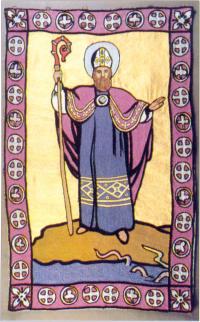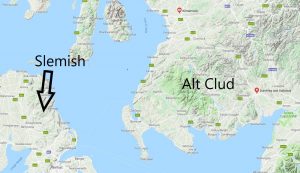One aspect of the myth of St. Patrick that I’ve always found peculiar is his early kidnapping and enslavement. Not the fact of it – Patrick’s Confessio is absolutely authentic, the fifth-century Irish enjoyed rich pickings in the decayed remnants of Roman Britain, and slavery was deeply embedded in Gaelic Irish culture. In Brehon law, a female slave (cumal) could be used as a unit of value in financial transactions. It took quite a few cumail to buy a horse, apparently.

No, what’s odd is the conflict between the general acceptance that Patrick was a Romanised Welshman and the place where he ended up herding sheep. Mount Slemish is between Ballymena and Larne, way up in the north-east and a long, long way from Wales. So a fairly unnatural place for a low-value boy-slave to end up.
Norman Davies’ wonderfully batty Vanished Kingdoms, (Allen Lane, 2011), suggests an explanation. The book aims to draw attention to European states that have disappeared virtually without trace, such places as Burgundia, the Visigothic kingdom in Spain known as Tolosa and (weirdly) “Éire”. For St. Patrick, the most interesting is the kingdom of Alt Clud, “The Rock”, centred at Dumbarton just outside Glasgow and taking in most of what are now Kilbride, Kilmarnock and northern Galloway.  In Davies’ account, the kingdom lasted from roughly the fourth century to roughly the ninth, and was North British in the original cultural sense, with its people speaking Cumbric, a p-Celtic language closely related to Welsh, Cornish and Breton. Part of the evidence is the only surviving authentic writing of Patrick’s apart from the Confessio. His Letter to Coroticus is a severe dressing-down aimed at a ruler identified by Davies as Ceredig Gueldig, the earliest king of The Rock. Who better for a bishop to wag his finger at than his own leader?
In Davies’ account, the kingdom lasted from roughly the fourth century to roughly the ninth, and was North British in the original cultural sense, with its people speaking Cumbric, a p-Celtic language closely related to Welsh, Cornish and Breton. Part of the evidence is the only surviving authentic writing of Patrick’s apart from the Confessio. His Letter to Coroticus is a severe dressing-down aimed at a ruler identified by Davies as Ceredig Gueldig, the earliest king of The Rock. Who better for a bishop to wag his finger at than his own leader?
Interpreting records from the period is notoriously problematic, akin to picking one’s way through a vast swamp using a few tiny, unstable stepping stones, but Davies’ performance is as nimble as a mountain goat. He makes it hard to resist the picture of the young Patrick on Slemish looking out across the narrowest stretch of water on the Irish Sea to his home in Alt Clud.
Happy St. Patrick’s Day.
Happy St. Patrick’s Day – John and everyone!
Thanks so much for the interesting post and especially for the link to the Confessio which I had never read before. I’m not even sure I knew it existed. It is a compelling read–amazing how the personality of someone who lived so long ago comes thru so distinctively. And it is, for me at least, meaningful spiritual reading, especially during this season of Lent.
What a wonderful story. Thanks for posting this link.
ur not saying were he came from he came from briteny im 9 and i know and u dont?!